

![]()
The Cycads:
Fossils of the Past
by Jose Manuel Sanchez de Lorenzo
Cáceres
The cycads are a group of very primitive ligneous plants bearing a superficial resemblance to palms, although they are not at all related. Without a doubt, cycads deserve the qualifying title of "living fossils," since this group of plants reached its highest point of evolution in the Mesozoic (about 200 million years ago) and, since then, has been declining, albeit without showing any appreciable changes in their evolution. Fossil cycads from the the Paleozoic (about 240 million years ago) have many characteristics similar to the cycads of the present time; thus, the name living fossils. Apparently, during the Triassic and Jurassic periods, the cycads enjoyed an abundant distribution, because nowadays, although often very localized, the existing species appear in places such as Polynesian, Madagascar, Japan, South Africa, tropical Africa, Australia, Mexico, Cuba, and Central and tropical America, which gives us an idea of the world-wide distribution that they had in the past.
The cycads, as already mentioned, have a habit similar to palms, with a turgid trunk and a crown of leaves at the terminus. The trunk can vary from several centimeters in height to several meters. They generally grow very slowly and possess remarkable longevity, with some live specimens being as old as 1,000 years.
Like the other gymnosperms, the cycads are ligneous plants, but the wood is spongy. The leaves are pinnate or pinnately- compound, with a heavy, ligneous base that generally persists on the trunk after the rest of the leaf falls. Leaflets can be directly opposed or alternating, toothed or smooth, and normally are quite rigid. The veination of the leaves serves to identify the three families of cycads, as follows:
Cycadaceae: Noticeable central vein and absence of lateral veins.
Stangeriaceae: Central vein marked and presence of lateral veins.
Zamiaceae: Numerous parallel, longitudinal, simple or graft veins.
All cycads are dioecious, that is to say, separate male and female plants exist. The reproductive structures are often massive cones of disproportionate size, reminding us a little of the other conifers that grow cones at the tips of the branches/stems. Instead of cones, female plants of Cycas species have megaesporophyls, which are modified leaves.
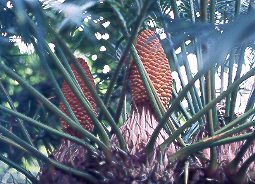 |
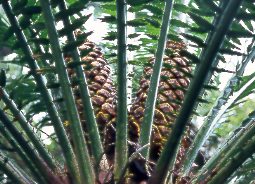 |
| Cycas riuminiana | Encephalartos laurentianus |
Although scientifically they are plants of much interest because of their enormous antiquity, economically the have little food value. Sago is extracted from the caudex of some species, which is used as food in certain areas. The seeds of some species are also processed into an equally nutritious flour. The main value of the cycads is based, then, on their ornamental appeal; for that reason some species, like Cycas revoluta are quite popular and are widely cultivated.
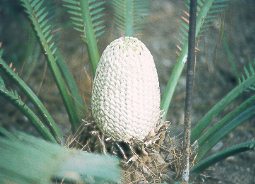 |
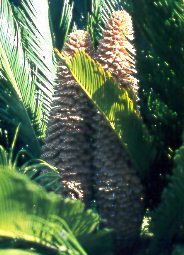 |
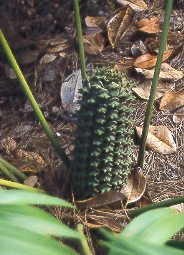 |
| Dioon edule | Cycas revoluta | Ceratozamia mexicana |
As much in the wild state as in culture, fertile seeds can only be formed when plants of different sexes grow near one another and their reproductive structures mature simultaneously. Artificial pollination is often conducted in culture to guarantee the formation of viable seeds. The seeds are sown at a shallow depth, shaded, and kept under high humidity. The period of germination is often slow and variable, oscillating between 50-100 days. Propagation can also be by removal of offsets that are born at the base of the trunk in some species and along the trunk in others. The cut must be thoroughly dried to avoid fungal rot. Apparently, a section of the trunk with a thickness of 5-7 cm, dried well, will also produce new plants in some species.
In general, cycads are quite resistant plants, with many species being adapted to zones of little rainfall; thus, when used as interior or landscape plants, they usually do not offer problems. They need abundant light and moderate water. The substrate must drain well, because excess moisture harms the roots. Equally, they prefer neutral or slightly acid substrates. A rich nitrogen fertilizer will cause their leaves to have a more showy and elegant lustre. As far as plagues and diseases, the cycads have few problems. They are relatively resistant to foliar fungi like Alternaria and antracnosis, as well as common insect pests like red spider mites. Many cycads will thrive in temperate zones outdoors. Cycas revoluta is probably the most cold-hardy species.
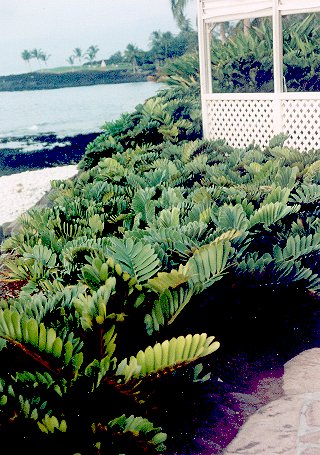 |
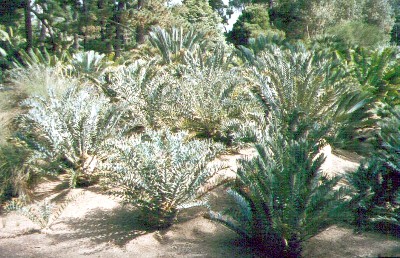 |
| Zamia furfuracea | Encephalartos horridus |
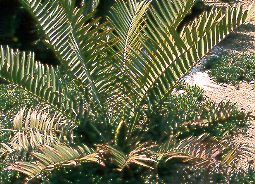 |
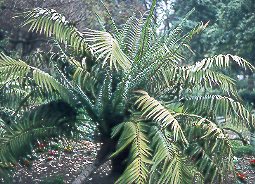 |
| Encephalartos altensteini | Ceratozamia mexicana |
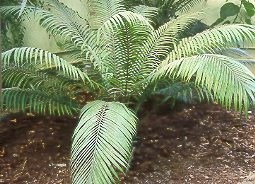 |
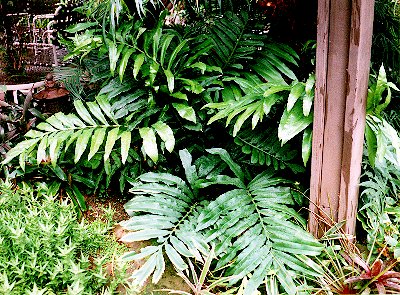 |
| Cycas media | Stangeria eriopus |
Family Cycadaceae is composed of only one genus, Cycas, which consists of about 20 species distributed from Polynesia to Madagascar and Japan. Of the cultivated species of cycads, Cycas is, without a doubt, the most popular, with C. revoluta being the "king." Other species commonly cultivated are C. circinalis, C. riuminiana, C. rumphii, etc.
Familie Stangeriaceae is formed by only one genus also, Stangeria, with a single native species in South Africa. Stangeria eriopus bears leaves remeniscent of the fronds of a fern in their aspect, and, indeed, it was first described as a fern.
Familie Zamiaceae is the most numerous family, with nine genera and around 80 species native to the tropics or temperate regions of Africa, Australia and the Americas. The genus, Zamia, includes 40 species of tropical and subtropical America. They have a short or imperceptible trunk. The diverse species are sometimes difficult to distinguish because leaves and leaflets can vary with age and the conditions of culture, making it necessary to examine the reproductive cones to differentiate them. Lately, several Zamia species have come into the nursery trade, mainly species such as Z. furfuracea, Z. pumila and Z. integrifolia. Other interesting species are Z. floridana, Z. latifolia, Z. angustifolia, etc.
Microcycas calocoma is a cycad with the aspect of a palm of up to 6 meters in native height and hails from the island of Cuba, where it is in danger of extinction. It is the only species in the genus.
The genus Macrozamia includes 14 species native to Australia. They have large trunks which, most commonly, are short and low to the ground. We can mention the following species: M. communis, M. diplomera, M. heteromera, M. lucida, M. moorei, M. stenomera, etc.
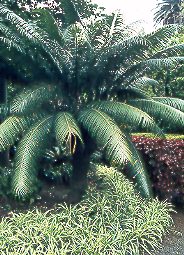 |
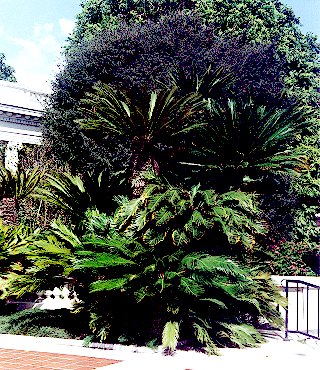 |
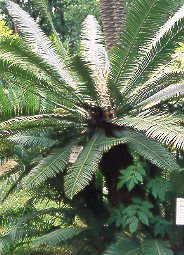 |
| Cycas riuminiana | Cycas revoluta | Dioon edule |
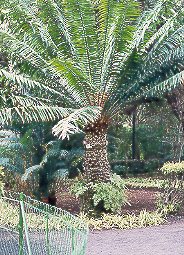 |
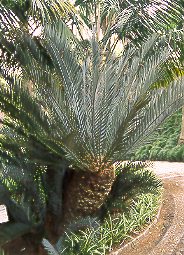 |
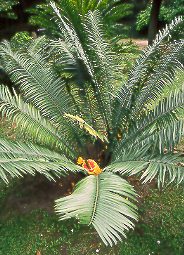 |
| Encephalartos laurentianus | Encephalartos lehmannii | Encephalartos villosus |
The genus Lepidozamia, with two native species also of Australia, sometimes is confused with Macrozamia at first glance. Lepidozamia peroffskyana is sometimes cultivated as an ornamental.
Coming from Mexico is the genus Ceratozamia, with two species, one of which, C. mexicana, is frequently cultivated. It has a short, somewhat curved trunk. Some varieties exist that are different in the shapes of the leaves.
The genus Dioon has four native species of Mexico and Central America. The most cultivated species in the genus is D. edule, whose seeds are edible. It requires average shade for its culture. The other species of the sort are D. dohenii, D. purpusii and D. spinulosum.
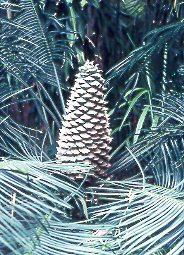 |
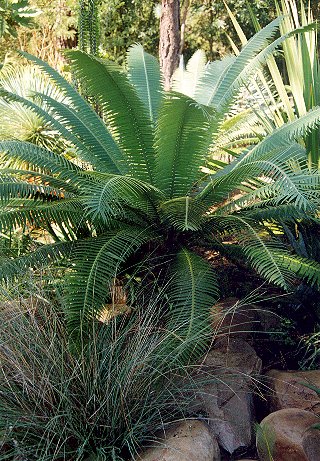 |
| Lepidozamia peroffskyana | Dioon spinulosum |
The genus Bowenia comes from Australia and has two named species, B. serrulata and B. spectabilis, and one unnamed, B. sp. 'tineroo'. All have underground stems and aspect of ferns and are not often cultivated. Some authors include them in the Family Stangeriaceae.
The genus Encephalartos is the most abundant in number of species, is in Africa. South Africa is the most speciose area, with some thirty species. They are becoming increasinbly more popular as landscape plants. Among the species of Encephalartos are E. laurentianus, E. horridus, E. altensteinii, E. lehmannii, and E. villosus, etc.
Finally, the recently described Chigua genus includes only two species, both native to Colombia: Chigua bernalii and Chigua restrepoi.
Photos and text are copyright © 1998-99, José Manuel Sánchez de Lorenzo Cáceres, and may not be reproduced without permission from the author. The article is reprinted here from The Trees of Spain website with permission.
![]()
| PACSOF Home Page | |||
| Virtual
Cycad Encyclopedia Site Map Powered by FreeFind. |
|||
This site is copyrighted © 1998, 1999, 2000, Palm & Cycad Societies of
Florida (PACSOF)
For questions or comments, e-mail the webmaster.
Internet hosting provided by Zone 10,
Inc.